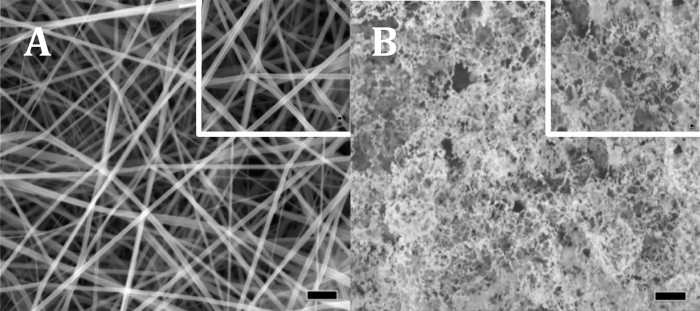This project originates from my previous work at the University of Connecticut, Professor Yu Lei's lab. In the past, the metal oxides from group 9 prepared by electrospinning and annealing process have been modified to the surface of bulky glassy carbon electrodes and screen-printed electrodes for the artificial glucose measurements and human serum glucose quantification. The nano-size of the formed cobalt oxide nanofiber (Figure 1), iridium oxide nanofibers (Figure 2), and rhodium oxide nanocorals (Figure 3) has greatly facilitated the mass transfer to the double-layer of the electrode surface and provided more accessibility of the direct electron transfer in non-enzymatic glucose sensing. Furthermore, the as-prepared sensors hold the sensitivity to the hydrogen ions in different Nearnst constants to indicate the acidity and alkalinity of the solution in the same unit. This dual functionality has greatly facilitated its potential applications in the next generation of long-term glucose monitoring and diabetes management.

Figure 1(A) Scheme: Experimental set‐up for the fabrication of PVP/Co(NO3)2−PVP precursory nanofibers using a coaxial spinneret. (B) A representative SEM image of PVP/Co(NO3)2−PVP precursory nanofibers (scale bar, 10 μm); inset shows the image with a higher magnification of nanofibers (scale bar, 1 μm). (C) A representative SEM of N‐doped hollow Co3O4 NFs (scale bar, 1 μm).(A) Scheme: Experimental set‐up for the fabrication of PVP/Co(NO3)2−PVP precursory nanofibers using a coaxial spinneret. (B) A representative SEM image of PVP/Co(NO3)2−PVP precursory nanofibers (scale bar, 10 μm); inset shows the image with a higher magnification of nanofibers (scale bar, 1 μm). (C) A representative SEM of N‐doped hollow Co3O4 NFs (scale bar, 1 μm).

Fig. 2. Typical SEM images of IrCl4/ PVP nanofibers (A) and IrO2 nanofibers after calcination at 900 °C for 3 h (B). Inset: higher magnification of IrCl4/PVP nanofibers and IrO2 nanofibers. Scale bar is 1 μm in A and B and 100 nm in Inset, respectively.

Fig. 3. Typical SEM images of (A) electrospun RhCl3/PVP precursory nanofibers and (B) Rh2O3 nanocorals after calcination of electrospun RhCl3/PVP precursory nanofibers at 700 °C for 3 h. Scale bar = 1 µm.
With the shifting for further developing the non-enzymatic glucose sensors, a few works are now underway for a combination of measurements of a few molecules in the blood.
Related Articles:
1. Dong, Qiuchen, Xudong Wang, Haomin Liu, Heejeong Ryu, Jing Zhao, Baikun Li, and Yu Lei. "Heterogeneous Iridium Oxide/Gold Nanocluster for Non-enzymatic Glucose Sensing and pH Probing." Engineered Science 8 (2019): 46-53.
2. Dong, Qiuchen, Xudong Wang, William S. Willis, Donghui Song, Yikun Huang, Jing Zhao, Baikun Li, and Yu Lei. "Nitrogen‐doped Hollow Co3O4 Nanofibers for both Solid‐state pH Sensing and Improved Non‐enzymatic Glucose Sensing." Electroanalysis 31, no. 4 (2019): 678-687.
3.Dong, Qiuchen, Donghui Song, Yikun Huang, Zhiheng Xu, James H. Chapman, William S. Willis, Baikun Li, and Yu Lei. "High-temperature annealing enabled iridium oxide nanofibers for both non-enzymatic glucose and solid-state pH sensing." Electrochimica Acta 281 (2018): 117-126.
4.Dong, Qiuchen, Yikun Huang, Donghui Song, Huixiang Wu, Fei Cao, and Yu Lei. "Dual functional rhodium oxide nanocorals enabled sensor for both non-enzymatic glucose and solid-state pH sensing." Biosensors and Bioelectronics 112 (2018): 136-142.
5. Dong, Qiuchen. "Dual Functional Metal Oxide Nano-materials Enabled Sensors for both Non-enzymatic Glucose and Solid-state pH Sensing." (2018).
6. Dong, Qiuchen, Heejeong Ryu, and Yu Lei. "Metal Oxide based Non-enzymatic Electrochemical Sensors for Glucose Detection." Electrochimica Acta: 137744.
Funding source: Xi'an Jiaotong-Liverpool University, Department of Chemisry, RDF-21-01-005, The high-temperature enabled metal oxides for the glucose detection and the solid-state pH sensing.
